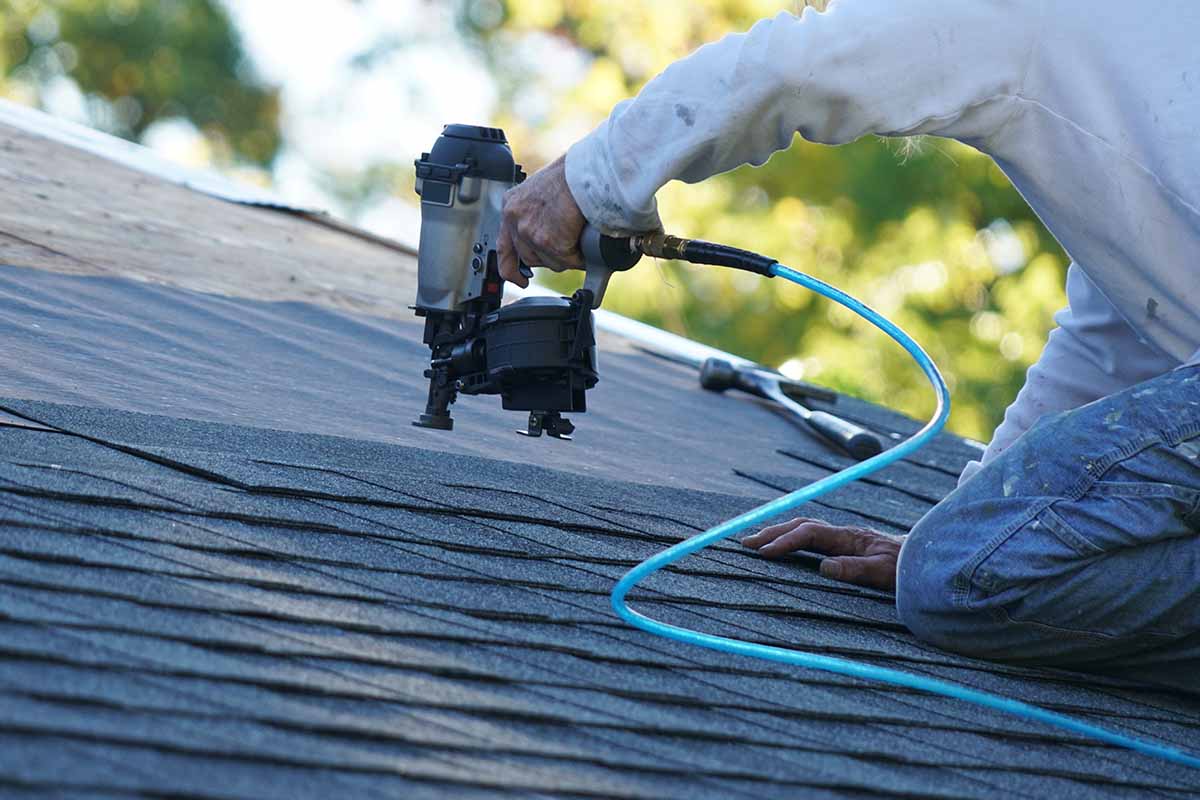A Comprehensive Overview to the Installment Process for Your New Roof System
The installation procedure for a brand-new roof needs cautious consideration of various aspects. From reviewing the roof covering's structural integrity to choosing suitable materials, each action plays an important role in ensuring a successful result. Recognizing the subtleties of setup can stop future concerns and enhance longevity. What are the necessary actions one must follow to achieve a dependable and resilient roofing system? The response hinges on an organized technique that resolves every important facet.
Understanding Different Roofing Materials
When selecting a roof, understanding various roof products is crucial for making an informed choice. Various products offer distinct advantages and disadvantages, influencing toughness, cost, and aesthetic appeals. Asphalt tiles are popular for their cost and convenience of installment, making them a typical selection for properties. Steel roof covering, understood for its longevity and resistance to severe weather condition, appeals to those looking for longevity. Clay and concrete tiles offer an one-of-a-kind visual and outstanding insulation yet can be much heavier and more costly. Slate roofing, celebrated for its all-natural charm and outstanding lifespan, often tends to be a costs choice needing knowledgeable installation. For environmentally-conscious home owners, environment-friendly roof, which include greenery, present lasting advantages. Recognizing these products permits home owners to align their choice with spending plan, climate factors to consider, and individual style preferences, eventually ensuring a roofing option that satisfies their needs effectively.
Examining Your Roof's Structural Honesty

Assessing a roofing's architectural integrity is essential for ensuring its long life and safety and security. This process entails inspecting the roofing system framework for any kind of indications of weakness, recognizing prospective water damage, and identifying the tons capability to sustain various roofing materials. Addressing these factors will certainly assist maintain the general wellness of the roof covering system.
Examining Roofing Framework
Before installing a new roofing system, it is important to thoroughly examine the roofing structure to verify its structural integrity. This process includes examining essential elements such as rafters, trusses, and the general framework design. A certified inspector ought to look for signs of wear, bending, or any structural shortages that can endanger the brand-new roof covering installation. Additionally, it is important to check for appropriate load circulation, making particular that the framework can sustain the weight of the new products. Any kind of recognized problems must be resolved prior to continuing, as they can bring about considerable troubles down the line. By prioritizing this evaluation, home owners can guarantee a dependable and long lasting roof covering system that will certainly withstand the test of time.
Determining Water Damages
Water damages can greatly impact a roofing system's architectural stability, making it essential to identify any type of indications early in the assessment procedure. Home owners should look for discoloration or stains on ceilings and walls, which may suggest leakages. Drooping locations in the roofing system or ceilings recommend accumulated wetness that can endanger architectural components. Examining the attic is essential; mold development and damp insulation are indications of water intrusion. Furthermore, examining the roofing surface area for missing shingles, fractures, or corrosion on steel components can reveal prospective vulnerability to water damage. Routine analyses can aid in early detection, permitting timely repair work that preserve the roofing's honesty and avoid extensive damages. Resolving these indicators promptly is necessary for preserving a safe and sturdy roof covering system.
Reviewing Lots Ability
Examining the lots ability of a roof covering is crucial for assuring its architectural honesty and long life. This evaluation involves checking out the products used in the roof's building, the underlying structure, and the overall layout. Elements such as snow buildup, wind tons, and the weight of roof covering materials have to be considered to identify whether the structure can sustain additional tons. A structural designer can provide useful understandings, conducting computations based upon local building ordinance and ecological problems. Regular inspections and upkeep additionally play an essential role in identifying prospective weaknesses. By extensively evaluating load capability, home owners can avoid expensive problems and make sure that their new roof system is risk-free and sturdy for several years ahead.
Preparation and Readying for Installment
Effective preparation and prep work are essential steps before setting up a roof system - pacific mo roofing companies. This involves examining certain roof covering demands and picking the appropriate materials that best fit those demands. A thorough understanding of these elements can considerably affect the success and durability of the roof covering task
Examining Your Roof Covering Demands
Just how can one ensure that their roofing task fulfills both visual and practical demands? An extensive examination of roofing demands is important. This includes analyzing the present roofing system's problem, identifying any type of damages, and identifying structural integrity. Homeowners should consider their environment, as climate condition considerably influence roof product choices and longevity. Additionally, evaluating architectural style and community aesthetic appeals is necessary for preserving home worth and appeal. Understanding personal preferences and budget constraints additional aids in making notified decisions. Seeking advice from with roofing specialists can offer valuable understandings and referrals tailored to particular demands. By meticulously resource assessing these variables, homeowners can guarantee their roof task aligns with their distinct needs and boosts their building's overall appearance.
Selecting the Right Products
When selecting materials for a roof task, it is vital to think about both performance and appearances to assure a successful installment. Homeowners ought to think about the environment of their area, as particular materials carry out much better under certain weather conditions. Metal roofs offer durability in areas vulnerable to hefty snowfall, while asphalt roof shingles may be much more cost-effective for milder environments. In addition, the design of the home plays a considerable duty; products ought to complement the architectural design to improve visual appeal. Sustainability is an additional variable; environmentally friendly alternatives like solar floor tiles or recovered timber can decrease environmental impact. Ultimately, selecting the ideal materials involves balancing these elements to protect a durable and visually appealing roofing system.
Security Preventative Measures During Installment
Making sure safety during roof installation calls for precise focus to detail and adherence to established protocols. Firstly, workers must wear suitable individual safety devices (PPE), including headgears, gloves, and non-slip footwear, to reduce injury threats. Scaffolding and ladders must be securely positioned and maintained to provide stable job surface areas. It is important to check the roof covering structure for weak points or damages before beginning work, as this can stop accidents in the future.
Furthermore, installers need to be trained in fall protection strategies, including making use of harnesses and guardrails. Climate condition likewise play a substantial role; job must be held off throughout high winds, rainfall, or storms. All tools and products ought to be arranged and secured to avoid tripping dangers. By prioritizing these safety and security precautions, the risk of crashes can be notably lowered, guaranteeing a more secure working environment for all entailed in the roof installment procedure.
Step-by-Step Setup Refine
A successful roof covering system setup entails a series of carefully prepared actions that ensure both performance and quality. The old roofing material need to be eliminated, making certain the underlying structure is undamaged. Next, any type of needed repair work to the roofing deck are performed, strengthening its stability. Following this, a moisture obstacle is set up to protect against water seepage. The option of roof material, such as shingles or steel panels, is then laid out, beginning from the eaves and proceeding upwards. Each piece is safeguarded diligently to stand up to weather. Air flow systems are incorporated to advertise air flow and prevent dampness accumulation. Flashing is mounted around vents and smokeshafts to further guard against leakages. Finally, the installment is assessed for compliance with local structure codes and maker requirements. This complete method guarantees a reputable and durable roof that satisfies home owner assumptions.
Completing Touches and Inspections

Once the installation of all components is complete, a comprehensive assessment adheres to. This includes checking for correct placement, safe and secure fastening, and appropriate securing of joints. Assessors additionally assess air flow systems to assure peak airflow and wetness monitoring.
In addition, any kind of particles or remaining materials from the installation must be gotten rid of from the roof covering and bordering area. By meticulously participating in to these information, homeowners can guarantee that their brand-new roofing system is not only practical however also aesthetically appealing, establishing the stage for long-term efficiency and toughness.
Maintenance Tips for Your New Roof covering
While lots of property owners might neglect the importance of normal roofing system maintenance, next page developing a routine can greatly extend the lifespan and performance of a new roofing system. Normal examinations ought to be carried out at least twice a year, preferably in spring and fall, to determine any type of potential concerns early. Home owners must check for loosened or absent roof shingles, signs of wear, and debris accumulation in valleys and gutters.
Cleaning the roofing surface area and rain gutters is vital to avoid water damage and mold and mildew growth. Furthermore, cutting overhanging branches can lessen damage brought on by falling particles. It is also a good idea to monitor interior ceilings for signs of leakages or water discolorations, which might show roof covering problems.
Involving a specialist for yearly inspections guarantees that any type of underlying issues are addressed quickly, preserving the integrity of the roofing system and providing peace of mind for homeowners.

Regularly Asked Inquiries
How much time Does the Roof Installation Process Typically Take?
The roof covering setup process generally takes one to three days, depending on the project's dimension and intricacy. Elements such as weather and the kind of roofing product can additionally affect the total timeline.
What Allows Are Needed for Roof Installment?
The required licenses for roofing system installation usually consist of building permits, architectural permits, and, in some locations, electrical or plumbing authorizations. Laws might differ based on regional codes, necessitating appointment with regional authorities for details demands.
Can I Stay Home Throughout the Installation?
Home owners can stay throughout roof covering installment, but it might be inconvenient his explanation because of noise and interruptions. Service providers suggest avoiding of workplace for safety and to permit the crew to do their jobs effectively.
Will My Insurance Cover the Roof Covering Installation Expenses?
Insurance policy coverage for roofing installment costs varies based upon specific policies and situations. Homeowners ought to consult their insurance policy company to establish eligibility for protection, including variables like damage intensity and plan specifications concerning roofing substitute.
What Takes place if It Drizzles During Installation?
If it rains throughout installment, employees may stop progression to stop damage to materials and guarantee safety. Rain can likewise delay completion, requiring additional time for drying and prospective re-evaluation of the roof covering project.
The installation process for a new roof covering system calls for mindful factor to consider of numerous variables. When choosing a roofing system, comprehending various roof covering products is crucial for making an educated choice. When choosing materials for a roofing project, it is essential to take into account both capability and visual appeals to guarantee an effective installment. Making sure security during roof covering system installment needs precise attention to information and adherence to developed procedures. A successful roofing system installation involves a collection of meticulously intended actions that assure both performance and top quality.